Stylish bathroom design ideas

Bathroom design is not limited to the selection of good plumbing and furniture. This room should be both practical and elegant in appearance; if such a requirement is not met, it becomes much less comfortable to use. It's time to get acquainted with what modern designers have to offer at the end of the 2010s, what is now considered fashionable and relevant.





Trending today
The novelties of 2018 are focused on finding a combination of convenience, simple grace and functional excellence. Considerations of prestige, status and demonstration of material well-being recede into the background. It is necessary to harmoniously combine ergonomics and contemporary aesthetics.
The motive of relaxation and tranquility is absolutely dominant now.

Therefore, for several years in a row, most projects have been drawn up in the spirit of the Scandinavian style or loft.
Such outwardly different concepts still have several important overlaps:
color tranquility;
predominance of natural substances and textures;
conciseness and clarity of lines;
introduction of expressive details;
strict execution functionality.


Stylish bathroom design involves the use of decentralized lighting with soft diffused light. One lamp has long been out of fashion. This approach is recommended for soft romantics and those who want to decorate a relatively small bathroom. A more austere and restrained loft style necessarily includes softened dark tones and a predominance of materials that are emphasized industrial in spirit. In this case, the space should be open, the zoning should be light; a slightly casual approach to the interior is encouraged. The classic white scheme has not lost its significance today.




The advantage of the traditional solution is that it allows you to embody many design ideas and achieve true elegance on a limited budget. In addition, the problem of finding plumbing fixtures and furniture automatically disappears - it is not difficult to find components of a suitable color. But absolute sterility and a neutral, inexpressive plot have already gone out of fashion. It is required to use those elements that can dilute the white bathroom, add more natural motives and natural colors. Wooden panels and hanging cabinets, imitation of concrete and brickwork on the walls, "stone" floor tiles help to solve this problem.


This year, no designer will find any objection to the use of pot plants that are undemanding to light and waterlogging. As for the colors, the gray tonality has now become the undisputed leader - its delicate and noble appearance pleases almost everyone. To match the fashion, this color is combined with bright inclusions in certain places and diversifies its texture. It is not at all necessary to focus on only one gray paint in a traditional way, you can give preference to imitations of concrete and natural stones.
Experts believe that this design is best combined with various shades of patina and chrome verticals.


The combination of black and white paints in the form of a strip or a checkerboard cage has been an indisputably authoritative solution for many decades.And in 2018, the demand for such a plot does not decrease at all, it can be used both as a universal filling of the bathroom, and as an expressive accent in a separate part of it. But excessive pressure on contrasting drawings is not welcome, as is everything that can tire you. Beige, brick, truffle palettes, as well as colors for cappuccino consistently retain their leading positions, they can be used both individually and in various combinations.


In addition to simple monochrome options, you can use rich saturated shades. - green, wine and terracotta. But at the same time, an excess of thick tones compresses the space and mentally exhausts people. Therefore, they are now being addressed exclusively when placing accents. The naturalness that dominates current approaches is reflected in the selection of materials. Despite the impracticality of plank bathroom floors, designers are actively looking for ways to apply them.


Other suitable options are various types of bricks and marble, wood panels. Mosaic tiles have become another organic part of the current style. The most popular ornaments in recent months have become Byzantine, Oriental and Mediterranean themes. A mosaic apron at the level of the sink or bathtub will help introduce additional color splashes. Targeted aged tiles can be useful both to enhance and to weaken the created impression, especially if their texture is emphasized coarse.


The combination of materials with each other has recently turned out to be a fashionable step., moreover, the good taste of the owner is manifested in the choice of substances close in nature with an opposite texture to each other. Modern lighting devices not only contribute to the visual expansion of the room; they must definitely help in her zoning. In addition to the spotlights, which have already become traditional, it is quite possible to use floor lamps and imitation of lanterns. Details like these add coziness to the bathroom and eliminate the feeling of an operating room. Small accessories can be made of any material you like, as long as they look attractive.


Chrome is popular, but more and more often it is being replaced by mixers made of copper and brass, aged structures.
Restoring the stylistics of old plumbing to a new level should introduce characteristic "careless" motives into the atmosphere. The demand for grotesque and large geometric shapes is only growing now. Furniture products of a modern design harmoniously connect with the walls without clear boundaries, built-in consoles, toilet bowls that enter the wall and parts masked by false panels are especially good. With due diligence, the most original and beautiful concepts can be realized.


Fashionable solutions
The classics in the bathroom interior can be preserved, but now they are refracted a little differently than before. Despite the seeming immutability and stability evoked by the name, this style is dynamic and systematically evolving. Its main canons cannot be violated, but within the limits they have outlined, there is a lot of space for searches. So, white is a whimsical compromise in the play of light and shadow. There is nothing new in this step: it is just a return to the ancient tradition of using a similar tone.

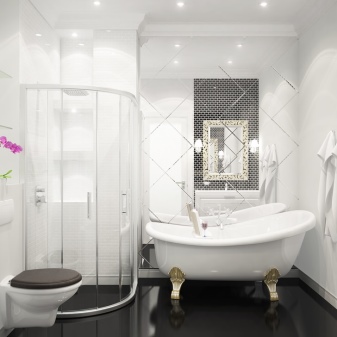
In the distant past, shades of yellow were invariably complex., rather, not like an artificial dye, but rather like autumn leaves. A modern reading of this approach is demonstrated by the contour gilding. The ancient Greeks knew a huge number of varieties of red paint, and there is no reason to refuse to imitate them. As for the black color, paints obtained by burning are at the height of fashion in the classic interior. It is also worth considering using the bluish green tones previously produced by copper acetates.


The classic style in the bathroom is justified only with a large area of it, and if there is not enough space, it is worth choosing single elements and notes of this approach. There can be no talk about the use of Corinthian or Doric columns, but it is quite possible to use a decorative plinth for finishing the contour lines. Space zoning is performed at the expense of small niches, and furniture should be visually soft and decorated with elegant textiles. What is important, even showers in the classic style are now being sold. In any case, all the main items and accessories when choosing a classic should be placed symmetrically relative to each other and in relation to the walls.




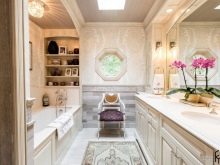
As before, finishing a bathroom in this style has nothing to do with ostentatious luxury and deliberate pomp.
Moreover, flashy tones and overly original elements will be intolerable. Preserved in 2018 and such a traditional feature as the active use of antique furniture. There can be no talk of a large crystal chandelier, but it is quite possible to replace it due to relatively large lamps. Light sources placed on the walls should ideally look like candlesticks, sometimes they are equipped with lampshades or shades.


Instead of parquet flooring, stone tiles are used in the bathroom. Even if you cannot buy real antique furniture, it is better to refuse products in which modern materials are clearly used. It is much better to use kits made by hand in leading factories, embodying the spirit of ancient samples. The room is made in the most correct form, the classic design does not tolerate any cut and rounded corners. The overall softness is further emphasized by the use of pastel colors.


The high requirements of the classic style to the volume of the premises make it possible to use it in far from all bathrooms. Therefore, it is logical to search for alternatives to it. Many homeowners prefer to design a bathroom in a Japanese style, and then the designers go to meet such a desire. Imagine such an approach intuitively, unlike the classics or modernity, it will not work. It is necessary to clearly understand the basic principles of organizing space and the fact that they cannot be reduced to simple minimalism of the European model.


The most important point, often overlooked, is the complete absence of accents. The gaze should not rest on individual elements. The structuring of the space is made calm and clear, the decor should be simple and ascetic, but at the same time it always contains a deep meaning. Japanese bathroom design will appeal to those people who do not accept the slightest chaos and disorganization. Also, those who strive to live in harmony with nature, slowly and measuredly, will be delighted with it. The walls will simply "disappear", or rather, the division with the help of rigid structures is replaced by a functional division of space.


Ordinary items that are displayed in any other style are tucked away in cabinets and closed shelves in the Japanese bathroom. Glass is actively used to present furniture as if it were hanging in the air and not absorbing space. If textiles are used, they should be translucent.
Intrigue and exotic atmosphere are created with the help of:
sculptural figurines;
ikebana;
potted plants;
mats.
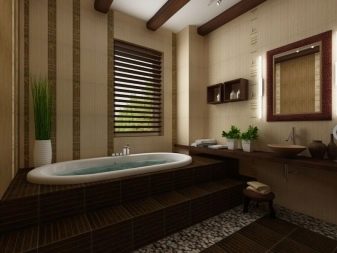

It is important to remember that the logic of the Japanese style is built on the play of contrasts, on emphasizing their mutual unity.
The contradiction is expressed mainly in color, for example, they often combine black with white or light beige tones with wenge color. Artificial materials are categorically unacceptable, and if there can be no talk of rice paper or straw in the bathroom, then bamboo and certain types of wood can be safely used. Baths in Japan are almost always made with a seating position.If such a bold decision does not suit you, it is worth completing the stylistic picture using hieroglyphs, images with pagodas and sakura, displaying bonsai.


Among all the possible tones, the Asian concept prefers light pastel solutions. Chocolate, white and black tones are often used as a contrast to them. Unlike the classics, they must be flawless, this format will not tolerate any originality and attempts to play with light and shadow. Niches are not just cute additions to the design of the space, their use is strictly prescribed by the canon. The more luminaires, the better, and at the same time they should be so closed that an attractive twilight is created.

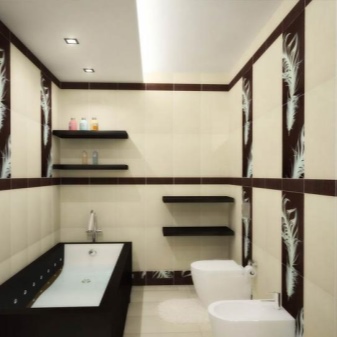
Modern ideas, regardless of the style of the bathroom, require at the same time to expand it in space and increase the functionality of the room. Over the years, more and more attention is paid to the design of plumbing fixtures, it becomes one of the main attributes of design. Virtually no one closes all walls with tiles, the combination of dissimilar materials has become much more popular. It is no longer fashionable to emphasize the bathroom in the usual sense, and at the peak of its popularity is its transformation into something completely different in appearance. Some practicing designers pay attention to the fact that among their clients there is a growing number of those interested in 19th century interiors.




The bathroom becomes a logical continuation of the rest of the ensemble of an apartment or house., especially often they are stylistically harmonized with the adjacent bedrooms. Household manipulations are tried, whenever possible, to be carried out separately, allotting another room for them. Almost no one wants to use the jacuzzi and hot tubs; they are being replaced by the most practical and rigorous solutions. LED strips as backlighting are also pushed to the periphery of the design, their use is permissible only if some design idea cannot be revealed in other ways.
Mixers of black color or made of brass are the most demanded.


Since they usually try to soften the border between the bathroom and spacious living rooms of the usual look, designers often use photographs, paintings and panels. Contrary to the obvious, the plots may not be related to water in any way, the main thing is that they bring joy, cause pacification. The architects note that the popularity of detached bathtubs is growing, and even small rooms are no longer considered an obstacle to such a solution. A freestanding bathing place immediately adds aesthetics to the room and raises its status. In addition, standard shower enclosures are gradually being replaced by special compartments, thanks to which the style is maintained more clearly.

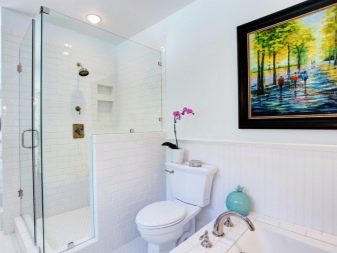



If shower cabins are made, then in a completely new look. Few people need pallets and doors, they just put tiled spaces with built-in ladders and an external fence. Of all the plumbing, only the drain hole and some of the controls are visible (as far as possible, they are trying to embed them into the wall). Partitions without frames give way to doors of an emphatically industrial look, with small glass-frit. The loft, leaving the living spaces, as one of the last positions has just the partitions of the shower compartments.





It is quite reasonable to choose Provence for decorating a bathroom; this style invariably remains in wide demand. There is no need to talk for a long time about the canon version of this approach, but it has certain subtleties and nuances that must be taken into account. Traditionally preserved light and pastel colors are gradually diluted with bright inclusions. It is very important to take care of high-quality and powerful lighting.
Along with white paint, it should be used for the most colorful decor:
wheat;
lavender colors;
the color of fresh foliage;
heavenly and sea shades;
woody black and sunny yellow blotches.




According to the designers, nowadays it is not necessary to create an overly dramatic and emotionally strong interior. It is much better to resort to its calm imitation, reproducing, for example, bricks of light colors or wallpaper with attractive paintings. Textiles are decorated with floral patterns, and if wood is complemented by carvings, then it should be outwardly simple and without any special aesthetic delights. Shabby, worn-out wood looks better than usual.


Squeak of fashion - the use of images of the Gallic rooster (both figurines and paintings on furniture, on the wall).


If the bathroom is decorated with flowers, then the actual modification of Provence requires putting them not in vases, but in jugs. A good alternative to this step is the use of dried herbariums, especially lavender, which saturate the air with the sweetest aroma. Among stretch ceilings, matte options are most in demand, especially when applying a floral print by photo printing. Whenever possible, it is worth using ceilings with pronounced beams. You cannot lay glossy tiles on the walls, only matte or "shabby" their design is permissible.




Natural and unobtrusive Provencal style, emphasized tradition of classics do not exhaust the leading trends in bathroom design. The third well-deserved place is occupied by the high-tech style, it also changes over the years and acquires new facets. Smooth edges, geometric simplicity, and the absolute superiority of artificial materials over natural ones remain in place. When decorating a room, only achromatic tones and neon shades of other colors are used. With shiny metal, glossy surfaces and a variety of lighting fixtures, the environment becomes free of boredom, becomes emotional and attractive.

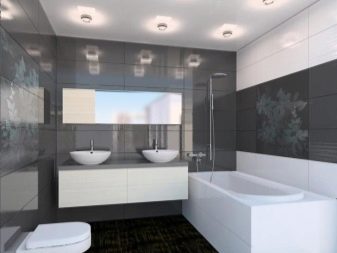


Patterns, ornaments and patterns are not used, the main emphasis is placed on the form and type of decoration. The only concession to classic themes that is allowed is the use of ceramic tiles. For the most part, it is taken with a uniform glossy color or a mosaic of relatively uniform tones is installed. Stretch ceilings are placed at the top, their painting is not regulated by the canons of style. Simple bathtubs with screens or shower boxes are unacceptable, only glass is acceptable, from which a cabin with straight lines is made.


Hi-tech is the style in which outdated LED lighting can still be used in the bathroom. If you don't like the idea of a shower stall, an asymmetric bathtub (delivered separately or leaning against a corner) with a chrome layer can replace it. The shells should be visually interesting and unusual in appearance. You can put lamps on furniture, as well as decorate windows with severe monotonous curtains and blinds.


Bronze, golden tones, images with everyday and natural motives, any drawings on plumbing accessories are categorically unacceptable.


Color spectrum
Having dealt with the stylistic preferences and nuances of their embodiment, you need to find out as much as possible about the colors in the bathroom. After all, any style allows you to use a variety of tones, and sometimes, on the contrary, the color acts as the inspirer of the style and organizer of the space. It is also necessary to take into account the emotional component of specific decisions. So, the red bathroom immediately stands out for its festivity and emotionality. But the design pressure of color should not be excessive, because in this case it reveals itself from the bad side and becomes overly aggressive.


If the bathroom is of medium or small size, the excess of red tones visually narrows them and causes a lot of inconvenience.
In a large room, you can safely experiment with:
Bordeaux;
burgundy;
pink and scarlet paints.


The solution for lovers of this color in a small space is to combine it with a white, black or milky palette. The choice of plumbing fixtures corresponding to the color scheme is also a serious problem; they are much less common than ordinary white ones. Basically, a red bathroom is an attribute of a modernist approach or high-tech format. Sometimes this color is used to express the flavor of Japan or the Arab East; it is least often found in a retro interior. When stylized as "good old England", red accents are used in the interior of the room.
They can be:
curtains;
rugs;
mirror frames and shades (lampshades);
individual pieces of furniture.





When choosing a way to dilute the monolithic redness, you should give preference to a white tone. It is this combination that will help increase the visible space, make it easier to get to know the details and does not seem unnecessarily harsh compared to others. If red furniture is used, it is advisable to highlight areas with a black tone for it. But the disadvantage of combining these two colors is that it will be attractive only over a large area. Despite all the decorating delights, you can be sure that the best bathrooms are always decorated in light colors.


The lighter the interior, the easier it is to deal with darkening in the corners. It is recommended not only to increase the number of lighting fixtures, but also to add mirrors, and even give up the bath in favor of a shower with frosted glass. Among light colors, beige, cream and the undisputed "king of lightening" - white bring the best results.
They can be applied in a wide variety of styles:
baroque;
Scandinavian;
country;
minimalistic;
modernist;
rococo and so on.






The addition of single contrasting tones immediately makes the situation more interesting and creates a kind of intrigue.


Before choosing a final decision, it is worth consulting with the designers and getting acquainted with the results of their work on specific examples. If possible, large windows should be mounted, then the design will sparkle with new colors and become as attractive as possible. Beige paint is as nice as white paint. But it is recommended to use it mainly in classic interiors due to its low compatibility with other styles.




Finishing
In bathrooms of a wide variety of colors, porcelain stoneware is widely used. The reason is simple - in the hands of experienced designers, this material displays the most unusual and extraordinary texture. At the same time, it is very strong and can be in harmony with exactly the same coating of the kitchen. Laying porcelain stoneware is possible only on those walls where there are no cracks at all. The presence of the old coating is not allowed, even in a very small amount.


Standard repair adhesives will not be able to hold the tiles to the surface. It must be glued with an exclusively specialized mixture, to which polymer components are added. It is recommended to immediately find out from the sellers whether the mixture will cope with the retention of porcelain stoneware. It is quite simple to mount the material, and it serves for a long time.
Layout can be done:
immediately over the entire surface;
in the form of a pattern;
in a mosaic version.


When processing the floor, it is advisable to take matte porcelain stoneware. It retains less moisture and reduces the risk of falling. But polished blocks are much better on the walls. There, their smooth and reflective surface will help improve the lighting of the room, even expand it. For your information: porcelain stoneware is not suitable for small spaces in combination with ceramic tiles. The differences between the textures are too strong.
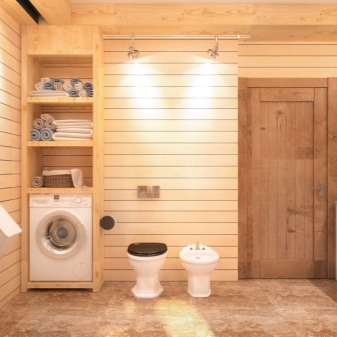

The most difficult thing is to choose the right shade of material for the ceiling, at the slightest mistake, the bathroom will be visually underestimated.But to cover the bath with porcelain stoneware is quite appropriate: in addition to external freshness and originality, such a coating will provide decent protection against electric shock. Modern samples of tiles hardly wear out and are little susceptible to the destructive effect of household chemicals; upon contact with it, the appearance remains unchanged. Even with an accidental impact, the finish will not be broken.


The disadvantages of this solution are the high cost of products, the need to do all the work as carefully as possible.
At the slightest miss, when uneven areas or air cushions remain, there is a high risk of cracking of the cladding. But you can duplicate the texture of natural materials as accurately and deeply as possible. There are solutions with imitation of parquet or natural leather. In small rooms, a square tile with a side of 0.3 m is preferable.


Plumbing
When making bathroom renovations, you need to pay attention not only to furniture and finishing materials, colors and styles. You also need to think about plumbing devices. Along with the typical pair - a bath and a sink, a bidet, a shower cubicle, a hydraulic box, and a small sauna can be used. Some of the bathrooms are also home laundries, where, in addition to the washing machine, devices for sorting and drying clothes are installed. The most advanced version even uses a dressing table. The final decision is determined by the size of the premises, the needs of customers and their material capabilities.





All design, including the selection of plumbing, and the method of its installation is guided by the preservation of free space and visual expansion of space. In many cases, plumbing, in addition to a purely utilitarian function, turns into one of the key "highlights" of the interior. In this case, one should not forget about the ergonomics and practicality of one form or another, color. Whenever possible, storage systems with open shelves and racks should be preferred to those structures that are removed inside. But not all styles provide such a chance; many insist on leaving all the basic elements open.




The original execution of plumbing devices is justified if the goal is to form an atypical interior that stands out from the general background. Most often, a bathtub has non-standard features, because it is larger than other components and acts as a visual organizer of the room. "Rooks", "hammocks", ellipses, or an emphasized antique arrangement with curved legs will cost more than the usual option, but they justify the appointed fee.


If you do not want to vary the shape and method of installing plumbing, you can show originality due to the color, however, such kits are usually supplied to order. Washbasins with round and oval white bowls set on a darker countertop were at the top of demand this year.
Traditional shells in the form of a rectangle are practically not inferior to them.



Often the emphasis is on faucets, many of which are reminiscent of old devices. And even a simple coating for copper and brass can radically transform the appearance of a product, give it uniqueness and good quality. When choosing a style for plumbing equipment, it is recommended to combine the most popular styles with each other, looking for common features and sharpening them visually. If such a step does not suit you, you can think of formats that are less popular at a particular moment, but well-proven formats.





Beautiful examples
A bathroom with a window can be done in impeccable white colors. Due to the sufficient space, there are (from left to right) a washing panel, a bathtub and a shower cubicle. Active use of mirrors complements the lightest appearance of the room

In a large bathroom, the most unusual stylistic solutions and design moves can be used.Here, for example, there is an ottoman and a plant in a tub. An oval bathtub and a panoramic window complement the accepted concept and make the room very original.

In many apartments, even large bathtubs are combined with a bathroom. Shown here is how white plumbing blends with Scottish flooring and single gold accents in different places. The white color of the walls is emphasized by a stripe made exactly in the middle of the height.

More often, a bathroom combined with a toilet is made in a "Khrushchev" or a small modern apartment. Here is one example - a corner bathroom is discordant with an emphasized rectangular toilet. The separating ceramic structure hides the control components and the inspection hatch. Almost all elements are in white, with very few bright color accents.

A bathroom of 3 m2 can also be furnished in a very beautiful and elegant way. The photo shows how the joyful and attractive color of one of the walls radically changes the impression. The usual coldness of light tones is violated demonstratively. The original pattern on the wall above the bathroom is duplicated by a strip under the side of the bathhouse facing the exit. The rectangular sink, separated by a small gap from the cabinet underneath, looks very nice.

On an area of 5 m2, attractive joint projects are sometimes organized. The shower cubicle close to the toilet looks very nice here. The tinted glass used in the cab gives an original appearance.
In several places at once, an unusual color was used in the form of a moderately dark array, mottled with horizontal white strokes.

Here they acted differently, even providing for a heated towel rail. But the main highlight of the interior is the combination of white and green tones, refracted in a checkerboard manner. In the corners there are sanitary ware, including an elegant bathtub, the outer contour of which is semicircular, and the inner bed is made in a completely atypical format. There is only one color accent: this is a door that is much richer than the walls and floor in the bathroom.

Design Tips
A basic idea of what the latest trends in bathroom design are, you need to have. But besides this, there are a number of nuances that are familiar to professional designers, and at the same time are little taken into account by the general public. Knowing these moments, sometimes, without outside help, it is possible to create a very attractive and original interior. Or simply create a good environment, avoiding mistakes that would make any professional groan in frustration. So, according to experts, the very first step should always be the selection of color.

The most comfortable and correct solution is the use of pastel shades - blue, beige or green. Next, you need to decide how exactly they will be used: one thing is the continuation of the general range in the accessories used, and quite another is the construction of the interior in contrast.
It is important to remember about the emotional factor:
blue tone reduces tension;
green is able to muffle stress that has already developed;
white and beige paints will help you to collect your thoughts and immerse yourself in yourself.



Various red shades will help to start the morning with the most vigorous and upbeat mood: by varying them, you can avoid excessive saturation and an atmosphere overflowing with passions. Even if everything around is white or neutral, bright scarlet towels or other removable accessories will be an excellent solution. Moreover, if necessary, they can always be changed in a matter of minutes. Tiles with a rich color can deceive the eye and narrow the room. But the circumvention of this limitation is simple - you need to take not a simple tile of the color you like, but a mosaic version.


When a color is chosen, only then begin to think about the preferred style, and not vice versa. It is also impossible to skip this moment, because it will determine the type of materials, and the design of furniture, and the appearance of plumbing, and the nuances of lighting equipment. If you really like a certain style, but for some reason does not fit into the room, you can make compromises and create hybrids. The opinions of venerable design gurus are one thing, but the real practical needs of people are completely different.
Don't be shy about improvising or trying to show your individuality.




If you plan to remodel the lighting, it is better to get professional advice or even prepare a full-fledged project. The variety of devices produced by modern industry, plus many schemes for their connection, plus types of wiring and auxiliary devices, complicate the right choice. In any case, the streams of light should be distributed evenly, and the lighting device should optimally complement the decor of the room. It is advisable to think over the masking of elements that are obviously unpleasant for the observer (for example, pipes and a cistern). If you need to work out the most compact solution, the angular format comes to the rescue.




Rugs with a rubber inner layer and perforation are much more practical than fleecy coverings. If you want something original, fresh, panels and pots, appliqués on the walls come to the rescue. Many of these parts can be made independently, not to depend on anyone and not to adjust your taste to someone else's assortment. It is useful to think about the desired textiles, curtains and cosmetic accessories - whether they will undermine the harmony of the created image. A gross mistake when decorating the walls of a small bathroom is the use of a dark base, isolated from the light top with a border.




Experts consider a combination of dark and light walls much more correct: such a contrast will immediately increase the external dimensions of the room. In miniature bathrooms, large-format tiles should not be used; instead, a glossy, light-colored finish should be used. A mirror mounted on the longest wall helps to get rid of the feeling of a carriage corridor when the sanitary unit is not wide enough and is extended in length. But if this technique is known to quite a few people, then the use of frosted glass and stained glass inserts also allows you to achieve a romantic effect. The best sanitary ware is produced in Italy and Germany.



See the following video for bathroom design ideas.













The comment was sent successfully.